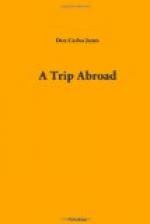CHAPTER III.
Asia Minor and Syria.
The Greek ship Alexandros left the harbor of Piraeus in the forenoon of Lord’s day, September eighteenth, and anchored outside the breakwater at Smyrna, in Asia Minor, the next morning. The landing in Turkish territory was easily accomplished, and I was soon beyond the custom house, where my baggage and passport were examined, and settled down at the “Hotel d’Egypte,” on the water front. This was the first time the passport had been called for on the journey. The population of Smyrna is a mixture of Turks, Greeks, Jews, Armenians, Italians, Americans, and Negroes. The English Government probably has a good sized representation, as it maintains its own postoffice. The city itself is the main sight. The only ruins I saw were those of an old castle on the hill back of the city. The reputed tomb of Polycarp is over this hill from Smyrna, between two cypress trees, but I do not know that I found the correct location. Near the place that I supposed to be the tomb is an aqueduct, a portion of it built of stone and a portion of metal. As I went on out in the country I entered a vineyard to get some grapes, not knowing how I would be received by the woman I saw there; but she was very kind-hearted, and when I made signs for some of the grapes, she at once pulled off some clusters and gave them to me. She also gave me a chair and brought some fresh water. More grapes were gathered and put in this cold water, so I had a fine time eating the fruit as I sat there in the shade watching a little boy playing about; but I could not converse with either of them on account of not knowing their language. On the way back to the city I stopped at the railway station to make inquiries about a trip to Ephesus.




